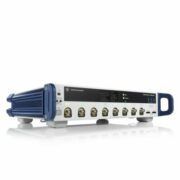Today, people greatly appreciate having electrical energy available at the flip of a switch, seemingly at any time and for any occasion. But where does electricity actually come from? The answer most people would give you is: “from the wall socket, of course”. So does this automatically settle the question of security of supply? More on this later.
If we compare the history of electric current with the history of Camille Bauer Metrawatt AG, it is easy to see how they were interlinked at certain times in the course of their development. Why is that so?
It was around 1890 when the so-called War of the Currents started in the USA. At that time, the question was whether the direct current favoured by Thomas Alva Edison (1847-1931) or the alternating current promoted by Nicola Tesla (1856-1943) and financially supported by George Westinghouse (1846-1914), was the more suitable technology for supplying the United States of America with electrical energy over large areas and constructing power grids. Because of Westinghouse’s market dominance at that time compared to Edison General Electric (called General Electric from 1890 on), it soon became clear that the alternating voltage invented by Nicola Tesla (who was of Serbian origin) was rapidly gaining the upper hand. This was not least because its approximately 25% lower transmission losses weighed unquestionably in its favour. Soon afterward, came the breakthrough for alternating voltage as the means of transmitting electrical energy using. Initially, the main target application was electric lighting, which to be spurred on by the invention of the incandescent lamp by Thomas Alva Edison. The reasons for this were logical. Westinghouse was initially a lighting manufacturing company and wanted to secure as great a market share as possible. As developments continued, it is therefore no surprise that already by 1891, in Germany for example, the first long-distance transmission of electrical energy was put into operation, over a distance of more than 170 km from Lauffen am Neckar to Frankfurt am Main. It was a technological breakthrough using three-phase current technology. However, this has by no means been the end of the story for direct current. Not least because of digitalization, electromobility, decentralized energy supplies, etc., DC voltage has experienced a full-blown renaissance and now is treated almost as a brand-new topic.
A journey back in time into the company’s history
The foundation of the Camille Bauer company dates back to 1900, immediately after the War of the Currents just described, at a time when electricity was rapidly gaining in importance. At the turn of the century, the Camille Bauer company, named after its founder Camille Bauer-Judlin, began importing measuring instruments for the trendy new phenomenon called “electricity” into Switzerland for sale to the local market. Some years later, in 1906, Dr. Siegfried Guggenheimer (1875 – 1938), formerly a research scientist for Wilhelm Conrad Röntgen (1845 – 1923) and who in 1901, became the first winner of the Nobel Prize for physics, founded what was virtually a start-up company in Nuremberg, Germany, trading under his own name. The company was engaged in the production and sale of electrical measuring instruments. However, due to pressure from the Nazis because Dr. Guggenheimer was of Jewish descent, he had to rename the company in 1933, creating the Metrawatt AG.
In 1919, a man by the name of Paul Gossen entered the picture. He was so dissatisfied with his employment with Dr. Guggenheimer that he founded his own company in Erlangen, near Nuremberg, and for decades the two rivals were continuously in fierce competition with one another. In 1944, towards the end of the Second World War, Camille Bauer could see that its importing business had virtually come to a standstill. All the factories of its suppliers, which were mainly in Germany (for example Hartmann & Braun, Voigt & Haeffner, Lahmeyer, etc.), had been converted to supplying materials for the war. At this point, a decision had to be made quickly. Camille Bauer’s original trading company located in Basel, undertook a courageous transformation. In order to survive, it turned itself into a manufacturing company. In a first step, the recently formed manufacturing company Matter, Patocchi & Co. AG in Wohlen was taken over, in order to be get the business up and running quickly with the necessary operating resources at their disposal. The Swiss manufacturing base in Wohlen in the canton of Aargau was born.










